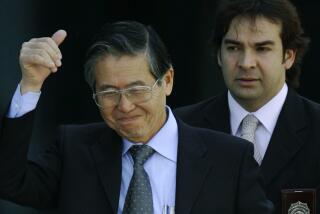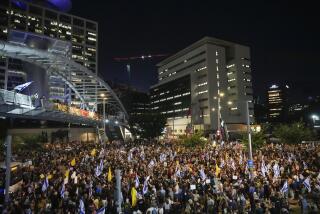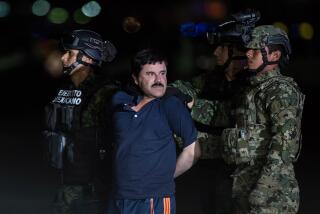Getting In Was Easy Part for Peruvian Guerrillas
- Share via
LIMA, Peru — Crowning years of tactical experience in terrorist combat, Nestor Cerpa Cartolini’s opening game was impressive.
Cerpa led a meticulously planned attack by the leftist Tupac Amaru Revolutionary Movement that captured hundreds of illustrious hostages in the Japanese ambassador’s residence here without a single casualty.
Cerpa’s middle game has looked uneven. The Tupac Amaru leader maintains a disciplined regime inside the barricaded mansion and holds his own in the war of words with the Peruvian government. But as the third week of the standoff drags to a close with no end in sight and 74 hostages still being held, he has not displayed negotiating talent great enough to resolve this extraordinary crisis.
Thus, urgent questions hang over the political chessboard of Peru: What is Cerpa’s end game? And how will this crisis end?
“Cerpa is one of the principal leaders of the Tupac Amaru, but he has mainly commanded the operational side,” said a diplomat who is knowledgeable about terrorism in Peru. “He is better at the military side than the political side. His talents are more geared to getting him into the residence than getting him out. There’s the rub.”
The rebels’ motives and the extent to which Cerpa has a master plan are the topic of fervent debate and speculation among Peruvian and foreign diplomats, law enforcement officials, journalists and politicians.
The rebels’ nominal demands include the release of about 400 imprisoned comrades, safe passage to the jungles of the Upper Huallaga Valley and vaguely defined economic reforms.
*
The guerrillas may also want to use the blaze of publicity to reinvigorate their armed struggle against the government or negotiate an entry into politics. And an unconfirmed report in a Japanese newspaper about a ransom demand for corporate executives fed the theory that the captors, veteran perpetrators of lucrative kidnappings, see the operation as a big-money score.
On Sunday, the Mainichi Shimbun newspaper quoted unnamed sources as saying the guerrillas first demanded $100 million from Japanese corporations, then lowered the figure to $30 million. Twelve corporations have officials inside the mansion.
Japanese Prime Minister Ryutaro Hashimoto denied reports of a ransom demand. “We have not even been sounded out, so we cannot even refuse,” he told reporters Sunday. Other Japanese government and corporate officials declined to comment.
Publicly, the hard line taken by Peruvian President Alberto Fujimori indicates that the terrorists will have to settle for less than they want. Fujimori has ruled out releasing convicts. His chief negotiator, Education Minister Domingo Palermo, has not met with the rebels for days. A visit to the residence Sunday by an unofficial intermediary, Bishop Juan Luis Cipriani, did not dispel the perception that negotiations are stalled.
“We are in the early part of the commencement of direct contact between the Peruvian government and the hostages,” said an official from another country. “The negotiations are perhaps even suspended.”
Tupac Amaru’s history offers comparable cases with varied endings. Cerpa led the takeover of a Lima factory in 1979 in which activists held out for 40 days until police stormed in, leaving four dead. In 1991, Cerpa’s jungle fighters captured nine police officers in the town of Rioja, held them for 28 days and released them unharmed through the mediation of a bishop.
And in December 1995, Tupac Amaru leaders took a family hostage when police cornered them in a house in a Lima suburb. The hostages survived, and the rebels surrendered after a gun battle in which they attempted a house-to-house escape by blowing their way through walls with dynamite.
Tupac Amaru has not exhibited the almost suicidal tendencies of Peru’s more fanatical leftist group, the Sendero Luminoso (Shining Path). The diplomat familiar with terrorism in Peru said, “They are very serious about this, but I don’t think their aim is to martyr themselves.”
Some experts say they believe that the rebels have already achieved their aim: a deluge of worldwide attention. Tupac Amaru has been reborn from the ashes, according to Hector Jhon, a former police general who commanded anti-terrorist operations in Peru.
“They had nothing to lose, so they made their last play, and it came out perfectly,” Jhon said. “They achieved their goal . . . attaining the pinnacle of popularity among Latin American guerrillas. Because at this moment, Tupac Amaru are better known in the world than Shining Path, the [Colombian] M-19” and other groups.
*
Others say the guerrillas want more than fame. Cerpa and his second in command, a wisecracking gunman nicknamed “the Arab,” eagerly sought out the intellectuals and politicians among their hostages to talk politics. Cerpa gave the impression that he has what Carlos Alberto Irigoyen, a veteran Peruvian diplomat and former hostage, called a “quixotic” aspiration to run for president.
Among Latin American guerrillas who went into mainstream politics, the case of the M-19 offers some parallels, because it was a Tupac Amaru ally.
In 1980, M-19 gunmen took over the embassy of the Dominican Republic in Bogota. Two months later, they negotiated safe passage to Cuba and reportedly pocketed millions in payoffs. The guerrillas subsequently formed a political party in Colombia and won a few elected offices.
The M-19’s transformation represents the ideal outcome of the Lima standoff for the Peruvian group, experts say. But the Colombian group controlled entire regions, while the Peruvian guerrillas operate only in a few jungle villages. The lack of a popular base makes acceptance into the political fold unlikely.
Far from considering such a political solution, even strident critics of Fujimori have closed ranks behind the president. Four representatives of the congressional opposition published a letter over the weekend emphasizing the need to preserve order. Rather ominously, a member of Congress suggested that, as “men of state,” the hostages might have to sacrifice their lives for the common good.
Such statements brought predictions that the Fujimori administration is laying the groundwork for an armed attack. But other observers doubt that will happen unless the terrorists harm or kill hostages.
“The government has opted for the path of dialogue, and it will be hard to abandon that path,” said Enrique Bernales, a former senator.
*
One point of potential compromise, analysts say, is prison conditions. Convicted terrorists are held in cold, dark, dungeon-like settings that are blamed for disease, insanity and suicide. Because the government had already begun redressing the excesses of its anti-terrorism war, it could conceivably agree to a humanitarian review of conditions without losing face, Bernales said.
Fujimori has offered to provide a commission to guarantee the terrorists’ safety if they release their captives. Most speculation about a peaceful resolution involves safe passage to a third nation. Cuba has been mentioned as a potential destination, but Cuban officials have declined to comment.
In a news conference last week in which he veered away from previous conciliatory statements, Cerpa rejected the idea that he wants safe passage out of Peru.
“If I wanted to leave the country, I would have done it clandestinely,” he told reporters.
Both sides agree publicly that they want to talk, not shoot, their way out of the crisis. But according to observers and officials familiar with the negotiations, they are not talking much. The end game looks a long way off.
Times staff writer Teresa Watanabe in Tokyo contributed to this report.
More to Read
Sign up for Essential California
The most important California stories and recommendations in your inbox every morning.
You may occasionally receive promotional content from the Los Angeles Times.










